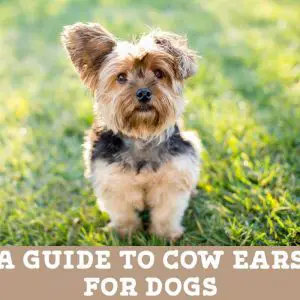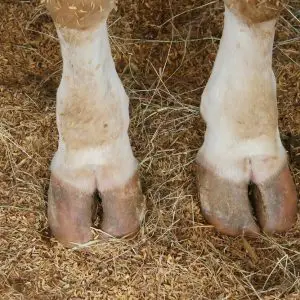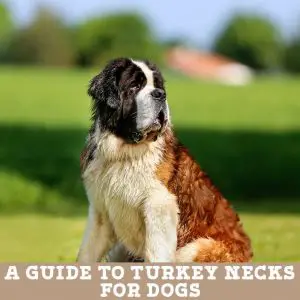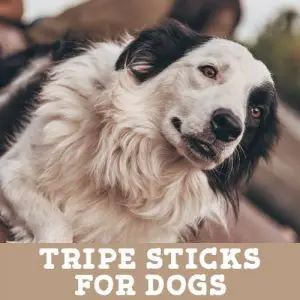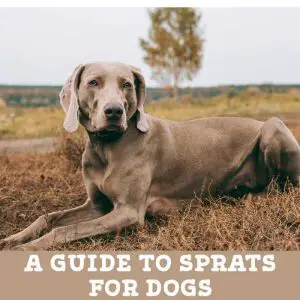You’re probably here because you are considering getting some lamb pizzle sticks. Pizzles are a popular natural dog treat, softer than many chews. But have you ever wondered what a lamb pizzle stick actually is? Pizzle is the old English word for penis – that’s right, a lamb pizzle is a lamb’s penis!
The penis consists of muscular tissue, just like any other meat source, so it’s really not that strange. If you’ve seen pizzles in the store and wondered if you should buy some for your dog, make sure you read this guide first. We’ll discuss the benefits and risks of pizzle sticks and everything else you need to consider before making up your mind.
Key facts
Lamb pizzles come from lamb or ram penises processed for the pet trade industry.
Pizzle sticks are high in protein and only have a moderate fat content, so they are a very nutritious treat for your dog.
Watch out for the calories; lamb pizzles are energy dense, so only feed them to your dog occasionally.
If you don’t like smelly treats, be sure to pick up the odourless varieties.
Many lamb pizzles are air-dried and not cooked at high temperatures, so there is a risk of bacterial contamination regardless of product source.
What Are Lamb Pizzle Sticks?
Lamb pizzles are derived from the penis of lambs or rams. The meat is air-dried (sometimes heated) and stretched to form long fibrous chews or strands. Plaited strands make a braided, chunkier chew. As always, avoid smoked products; they provide no additional benefits and might even be harmful to your pet.
Some pizzles consist of strips of lamb skin rather than penis. But whatever the origin, they are 100% lamb and shouldn’t contain other constituents or additives. Drying reduces bacterial contamination and extends shelf-life, so pizzles should be preservative and salt-free.
Many pizzle sticks marketed online are manufactured in Turkey, which is outside EU jurisdiction. However, with the explosion in popularity of the natural pet product market, some boutique dog treat companies are manufacturing pizzles in the UK. Buying UK-made pizzles, produced under the Food Standards Agency’s guidelines for pet foods, gives peace of mind. EU products are also a good alternative.
Bull’s pizzles have been around for some time and have a rather unpleasant stench. Thankfully, there are now ‘odourless’ lamb and beef pizzle varieties on the market. Hot water washing reduces the pong before the drying process. So, while these are not entirely scent-free, they might make your house a little less smelly!
Always store dried pizzles in a cool place, inside an air-tight container. If you bulk-buy, there is also the option to freeze them, but make sure they are fully defrosted before offering them to your dog. If you opt for freezing, keep them well away from human foods, ideally in a separate freezer.
Controversies Surrounding Lamb Pizzle Sticks
A 2022 report in the Veterinary Record described the risks of bacterial contamination associated with pet treats derived from dried meat. While many pizzle sticks are heat treated, some are not. Whether warm air drying reaches adequate temperatures to eliminate pathogenic (or harmful) bacteria is unclear. Indeed, this study identified pizzle sticks as a source of Salmonella enterica, a nasty bacteria that can cause symptoms in humans and animals ranging from mild gastroenteritis to sepsis (a life-threatening blood infection).
But this is not new information. A 2021 report in the journal Animals outlines the numerous bacterial and fungal risks of air-dried treats and the threat this poses to animals and humans alike. Obtaining treats from a reputable source, and ensuring correct storage and use within a product’s shelf life will at least reduce these risks a little.
Raw Feeding
Did you know?
Raw feeding is a popular choice for many dog owners for many reasons. Lamb pizzles are halfway between raw and cooked food; some are technically baked and therefore not raw, and some are air-dried at cooler temperatures. Handle pizzles carefully with strict hygiene in mind, as with all raw food products.
Pizzles are a treat and should not be considered a core constituent of any meal. However, given their high protein content derived from muscle, they can be deducted from the meat ration of a raw-fed pet’s diet. Be sure to consider the high-calorie content too, and adjust your feeding plan accordingly.
Nutritional Information for Lamb Pizzle Sticks
Lamb pizzle sticks are super-high in protein which means they are full of important muscle-building and healing nutrients for your dog. The fat content is reasonably low, although not suitable for dogs on a fat-controlled diet, i.e. those with pancreatitis.
The chart provides an average guaranteed nutritional analysis of lamb pizzle sticks.
Lamb Nutrition
Note: The percentages don’t add up to 100% as they are averages from several data sources.
Use Sparingly
Pizzle sticks vary enormously in length and density. So calorie content varies widely. A small lamb pizzle might provide just 60 kcal, but at the larger end of the scale, it could be as much as 135 kcal, which is pretty high!
This means that a large pizzle might contribute 7% of your dog’s daily calorie requirements for a large-giant breed dog but up to 30% for a toy breed – impressive! Remember: treats should make up no more than 10% of your dog’s daily calorie intake. So, ensure you get the appropriate size pizzle for your dog and always feed in moderation.
Dogs that are not neutered and working dogs can consume considerably more calories than those hounds that like to spend the day curled up on the sofa, so be sure to adjust your dog’s energy intake to fit their lifestyle. There are some basic calculations that you can use to help guide you on this.
Feeding guide
Feeding guidelines vary; however, it is most important to check that you are giving your dog the right size pizzle to gnaw on. Larger breed, energetic dogs might enjoy a pizzle stick daily if they are not on a calorie-controlled diet. However, a smaller or more sedentary pet should only be offered one as a special treat or up to a couple of times a week.
Often marketed as softer chews suitable for younger and older dogs alike, pizzle sticks are an attractive alternative to harder chews. But pet owners’ experiences vary. Some say the chews last just a few minutes, while others state they last much longer, or that their older dogs find the pizzles too hard. The general consensus is that the smaller pizzles are a little softer and are more appropriate for small breed dogs than many other chews.
Dried pizzle sticks are full of flavour, so your dog might want to drink a little more after eating one. Make sure you have plenty of fresh water available to them throughout the day. Pizzles are not a great choice for pets with kidney disease because they are very high in protein and low in moisture.
Health Benefits of Feeding Lamb Pizzle Sticks to Your Dog
Key benefits
Great For Mental Enrichment
Chewing is great for your dog’s mental health and promotes calm, satisfied behaviours.
Dental Hygiene
Pizzles are a slightly softer chew that can provide teeth cleaning in younger and older dogs with more sensitive mouths.
High In Protein
Pizzles are full of protein, great for growth and healthy skin.
Lamb pizzles are a tasty, meat-based, high-value treat. Packed full of tasty protein, they have several health benefits:
Mental Health Benefits
Dogs love to chew! Chewy treats are great for enriching your dog’s day and producing feel-good endorphins in the brain. Research suggests that longer-lasting chews are the best at stimulating calm and positive emotions. This was shown to be particularly useful when dogs experience separation anxiety. Ideally, though, dogs should be supervised at all times with lamb pizzles.
For some dogs, pizzle sticks will last for up to an hour or more, but if you have a heavy chewer, they could be gone in a matter of minutes. If your dog gets through a pizzle in the blink of an eye, consider trying a stronger chew.
Teeth Cleaning
Any treat that encourages chewing and tearing will naturally have teeth-cleaning benefits. The action of chewing will also break down plaque and reduce oral bacterial load. And second to brushing, chewing is the best way to stop plaque from calcifying and morphing into tough rock-like tartar on your dog’s teeth.
High in Protein
Lamb pizzles are around 75% protein which means they are rich in nutrients. Proteins are important for healthy hair and skin growth, tissue healing and promoting the growth of muscles and cartilage. Just watch out if your dog is on a protein-controlled diet, and avoid if your pet has kidney disease or is prone to dehydration or constipation.
Low to Moderate Fat
Pizzle sticks contain low to moderate amounts of fat, so unless your dog is on a calorie-controlled diet or struggles to digest fats, they are healthier than some higher-fat treats.
Natural and 100% Lamb
The great thing about lamb pizzles is that most products are 100% lamb, so you know what you are getting. This is particularly important if your dog is intolerant to more common protein sources, such as chicken, but can eat lamb with no issues. Plus, if you strive to provide your dog with a natural diet, those pizzles without additives certainly tick the box.
Downsides and Risks of Feeding Your Dog Lamb Pizzle Sticks
Low-risk
The main risk with lamb pizzles is bacterial contamination as they are usually air-dried rather than cooked. Here’s a list of the main dangers to watch out for:
Bacterial Contamination
The biggest concern with pizzles and other air-dried dog treats is bacterial contamination. Salmonella, Clostridia and other bacterial species have all been isolated from shop-bought pet treats. These harmful bacteria can cause severe vomiting and diarrhoea, or even sepsis, a serious condition which requires hospital treatment.
Of course, temperature-treating pizzles will reduce the risk of bacterial contamination, but this is a step away from the product’s natural state.
If you are offering air-dried treats to your dog, always follow careful hand hygiene after touching the treats. Take special care with dog poop, and clean toileting and pet feeding areas with antibacterial products.
People that are young, elderly or immunocompromised should be ultra-careful when handling raw-fed pets and their food or treats. These members of the family should strictly avoid pet faeces altogether.
Choking
As with any chew treat, there is a risk of choking, especially if your dog bites and swallows chunks of the chew. Don’t offer your pet a chew that is inappropriately small as this will increase the choking risk. Some manufacturers will provide helpful size guidelines so check the packaging for this.
If you see your dog swallow a chew, speak to your vet immediately for advice and avoid giving that treat again in the future.
Weight Gain
Since this is a calorie-loaded treat, avoid pizzles if your dog is prone to weight gain or is on a weight loss plan. You also need to be careful in dogs requiring strict dietary control, such as diabetic patients – speak to your vet if you are unsure whether pizzle treats suit your dog.
Avoid if…
· Your dog is under 12 weeks of age.
· Your dog tends to bite and gulp down chunks of chew.
· Your dog is on a calorie-controlled diet.
· Your dog is allergic or intolerant to lamb protein.
· Your dog has a sensitive stomach or is prone to gastroenteritis
· Your dog or family member is immunocompromised (e.g. on chemotherapy or has an immune-mediated disorder).
Lamp Pizzle Sticks for Puppies
Pizzle sticks are generally not recommended for puppies under 12 weeks of age as they can be a little too tough to chew and may cause dental trauma. That said, pizzles are softer than many other chews and may be more suitable for your pup.
Always monitor your puppy closely when they have a chew stick, and remove them when they are small enough to swallow whole. You may also need to limit the chew time if your puppy is going at the chew with too much enthusiasm for an extended period.
Alternatives to Lamb Pizzle Sticks
If you’re looking for alternative treats to lamb pizzle sticks, consider these options:
Yak milk chews – these are a tasty natural alternative, which, for most dogs, provide a very extensive chew time. These are also great for dogs that require novel protein sources, but be aware that the EU yak bars contain cow’s milk, which should be avoided in lactose-intolerant dogs. These chews are too hard to offer to young puppies, and non-smoked varieties are preferable in general.
Fish jerky – this is a softer but much smellier chew! Perfect for younger dogs and fun scent games. Stick to EU-produced jerky treats, though.
Ostrich tendons – these have similar physical and nutritional properties to lamb pizzles but are generally lower in fat. They also contain a quirky novel protein source, great for dogs with food intolerances. Ostrich tendons might also be more appealing to dog owners who are a little squeamish when it comes to pizzles.
Lamb pizzles contain 100% lamb meat (generally dried penis) and are protein-rich. Pizzles can be a nutritious treat for those dogs with a robust digestive tract. But they are full of calories, so should be fed only occasionally and avoided if your pet is on a calorie-controlled diet.
Lamb pizzles are a low-risk treat, provided your dog does not gobble up large chunks, as they could be a choking hazard. Another concern regarding all air-dried dog treats is bacterial contamination, so strict hand hygiene is essential. Avoid feeding these to dogs with gastrointestinal issues or those that are immunocompromised.
Pizzle is an old English word for penis, so they are literally lamb penises. They are dried, stretched, and twisted or plaited, so they do not look quite as awful as they sound. Odourless varieties are more palatable to the human members of the household, although dogs tend to love all versions of pizzle!




